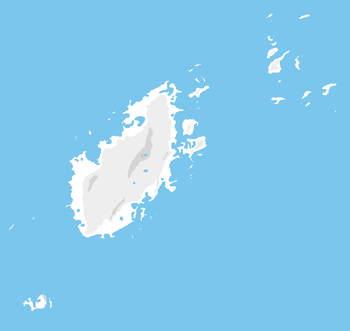Lahan
 | |
| Area | 1,300,000 km2 (500,000 sq mi) (guesstimate) |
|---|---|
| Demonym | Lahani |
| Countries | 2 (list of countries) |
| Languages | Ekuo-Lahiri, Sanju-Jutean, Shohuanese |
| Time zones | SCT +7/SCT +8 |
Lahan is one of the smaller continents (or larger islands) on Sahar. It is located east of Baredina and north of Ystel, forming the Puzimm straight with Puzimm and marking the far eastern bounds of the Paršita Sea. It is [very] approximately 1.3 million km² and composed of just a few countries, with a population of [still very approximate] 120 million people.
Lahan has a unique ecology, featuring very few mammalian species, and a large number of of endemic bird species, and is the original source of the rubber tree and other important plant crops.
History
Pre-Sañuan
Lahan has been inhabited by modern humans for at least ?? thousand years. Records of early inhabitants are sparse. It is known that ancient Lahani people first began producing rubber from the rubber tree at least ?? thousand years ago, and mostly kept to the coastlines, where they fished the plentiful waters.
Sañuan Migration
The Sañu people, a branch of the Sañu-Jutean Saru-Asuran people, first arrived on Lahan 1X,000ya, from ???. They outcompeted native inhabitants in the coastal zones where they arrived and spread along much of the island's coastline. They practiced limited early agriculture and ate a mostly vegetarian diet, supplemented by seafood.
Lahiri Migration
The Lahiri people of the Ekuo-Lahiri group came to Lahan in approximately BCE 6500 across the Puzimm straight from Baredina, originally settling only in small islands like the Ikang Islands between the two continents. The early Lahiri people first settled in what is now western Tuyo, displacing some of the Sañuan residents. They brought new forms of agriculture to the island and began spreading inland, clearing forest to make way for farms. This brought them into conflict with the native Lahani people.
Colonial era
From the early 15th century until the late 1??0s much(/all) of Lahan was under colonial rule, initially by the Neviran Empire and later by Shohuan.
Neviran Empire
The Lahiri people, as relatives of the Nevirans, had more culturally in common with their new occupiers than the earlier Lahani peoples did, and enjoyed a certain amount of privilege under them. However, all native groups of the island suffered under Neviran rule. Lahani natives were forced to work for the colonizers, producing high yields of natural rubber latex and food crops.
Geography and climate
Lahan is a small continent, tilted on its axis to point northeast and southwest. Most coastal areas are low-lying, creating expansive sandy beaches that lead to the thick inland tropical forests. It is nearly evenly split between equatorial (in the north/west) and tropical monsoon (in the south/east) climates.
==